




Spring or dual control switches operated by hand are considered hand-operated switches, and all rules goveming hand-operated switches apply to them, except that cars must not be dropped over the switches.
The employee handling the switch or derail is responsible for the position of the switch or derail in use. The employee must not allow movement to foul an adjacent track until the hand-operated switch or derail is properly lined.
Employees handling switches and derails must make sure:
When possible, crew members on the engine must see that the switches and derails near the engine are properly lined.
The normal position of a main track switch is for main track movement, and it must be lined and locked in that position.
However, the main track switch may be left open:
On main track switches (if equipped), the target will be red if the switch is lined in other than its normal position.
When an employee lines the switch to let a train enter or leave the main track, the employee must then go to the opposite side of the main track and not return to the switch stand until movement is complete. If unable to go to the opposite side of the track, the employee must stand at least 20 feet from the switch stand.
Do not return a main track switch to the normal position until movement is clear of the main track.
An employee getting off moving equipment to return the main track switch to normal position must, when possible, get off the equipment on the opposite side from the switch stand.
Except in switching movements, when a train or engine is approaching or passing on a main track, employees must not go nearer than 20 feet to any main track switch.
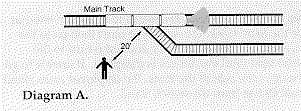 When a train or engine that will be met or passed is on a
siding or other
track, the employee attending the switch must not be nearer than 150 feet
to the switch
when the train is closely approaching.
When a train or engine that will be met or passed is on a
siding or other
track, the employee attending the switch must not be nearer than 150 feet
to the switch
when the train is closely approaching.
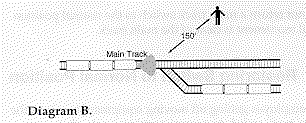 Inspecting Hand-Operated Switches in Non-Signaled
Territory
Inspecting Hand-Operated Switches in Non-Signaled
Territory
In non-signaled territory, if the expected train is not closely approaching, a crew member will inspect facing point, hand-operated switches the train will pass over to determine that the:
When not in use, switches must be locked, hooked, or latched if so equipped. Before making movements in either direction over these switches, make sure the switch is latched or secured by placing the lock or hook in the hasp. However, when making train movements in facing point direction, lock the switches equipped with a lock.
Replace any missing or defective switch locks. If they cannot be replaced, report the condition at once to the train dispatcher, yardmaster, or supervisor in charge, and spike the switch if possible.
Spring switches are identified by the letters "S" or "SS,"' special targets, signs, and/or lights.
A crew member tests the switch by lining the switch over and back by hand and examining the switch points to see that they fit properly.
A train or engine making a facing point movement over a spring switch must stop, and a crew member must test the switch when any of the following conditions exist:
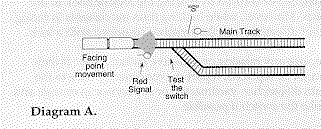
However, a crew member does not need to test the switch if it has been lined for the diverging route, or written instructions advise the crew that the spring switch has been spiked.
A train or engine trailing through and stopping on a spring switch must control the slack. A crew member must line the switch by hand before the train or engine can change direction or take slack.
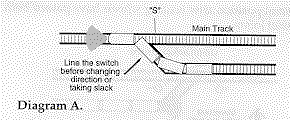
A. With Facing Point Lock
When a train is stopped by a signal governing trailing movement through a spring switch and the switch is equipped with a facing point lock, operate the switch by hand. Do not return the switch to normal position until after movement is complete.
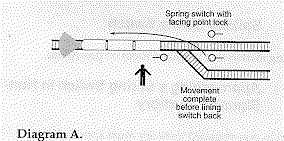 B. Without Facing Point Lock
B. Without Facing Point Lock
Before a train makes a trailing movement through a spring switch not equipped with a facing point lock, and only hand operation can establish block signal protection, line the switch for the intended route. Return the switch to normal position after leading wheels have passed both insulated joints.
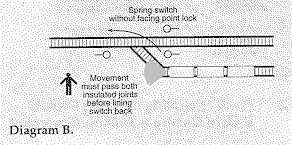
During snow storms, ice storms, or other conditions that may prevent a spring switch from functioning properly, avoid making a trailing movement through the spring switch until the switch has been lined by hand for the movement.
A spring switch that is spiked must be protected.
A train in non-signaled territory must approach the facing points of a spring switch prepared to stop until:
| Aspect | Indication |
|---|---|
| Green | Switch points fit properly in normal position. |
| Yellow | Switch points fit properly in reverse position. |
| Red | Stop and inspect switch. |
The normal position of switches connecting any track, except the main track, to a siding is lined and locked or secured for movement on the siding.
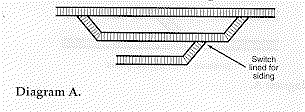
The normal position of crossover switches is for other than crossover movement. The switches must be left lined in normal position, except when they are in use for crossover movement.
Both switches of a crossover must be opened before a crossover movement starts, and movement must be complete before either switch is returned to normal position.
EXCEPTIONS: On non-signaled track, both switches of a crossover not connected to a main track or siding must be left lined either for normal movement or for movement through the crossover.
Dual control switches may be returned to power as prescribed by Rule 9.13 (When Instructed to Operate Dual Control Switches by Hand).
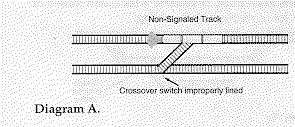
When scales are not in use, line switches for dead rails where provided.
When conflicting movement is closely approaching a switch, the track must not be fouled or the switch operated. Except at a spring switch, trains must not foul a main track or signaled track or pass beyond an insulated joint at the clearance point until the switch connected with the movement is properly lined.
Crossover switches must not be unlocked or lined for crossover movement when another movement is approaching or passing over either switch.
Do not run through switches, other than spring switches or variable switches. If a rigid type switch is run through, it is unsafe and must be protected by spiking the switch, unless a trackman or other competent employee takes charge.
An engine or car that partially runs through a switch must continue movement over the switch. The engine or car must not change direction over a damaged switch until it has been spiked or repaired.
Report a switch that is damaged or defective to the train dispatcher, yardmaster, or supervisor in charge. Spike the switch unless the trackman or other competent employee takes charge. If the switch cannot be made safe, provide protection at once.
When possible, avoid using sand over movable parts of an interlocking, retarders, spring switches, variable switches, or power-operated switches.
Trailing point movements may be made over a variable switch from either track, regardless of the position of the switch points.
When making a trailing point movement and the switch is not lined for such movement, make sure all wheels of the leading car or unit clear the switch points before changing direction.
During snow storms, ice storms, or other conditions that may prevent a variable switch from functioning properly, avoid making a trailing point movement through a variable switch until it has been lined by hand for movement.
The location of automatic switches will be designated in the timetable. To operate an automatic switch to enter the siding, a crew member must do the following:
After 40 seconds, the signal will display a restricting indication when the switch is lined for movement into the siding.
When the signal that governs movement over an automatic switch displays a Stop indication, the switch must be operated by hand before proceeding.
Operating an Automatic Switch by Hand
To operate an automatic switch by hand, the crew member must stop the train for the signal that governs movement over the switch and then do the following:
When the switch is returned to the POWER position and movement over the switch is complete, the switch will automatically return to its normal position.
On Siding. A train operating on a siding must be stopped before it passes the overlap sign until it is authorized to proceed.
Entering Main Track. A train that is about to enter the main track and is authorized to proceed must move past the overlap sign. Further movement must not be made until the signal governing movement over the switch displays a proceed indication. If the signal does not display a proceed indication within 5 minutes, a crew member must operate the switch by hand as specified in Rule 9.17 (Entering Main Track at Hand-Operated or Spring Switch), waiting an additional 5 minutes, if necessary.
When automatic switches are operated by hand, all rules governing hand-operated switches apply, except cars must not be dropped over the switches.
Employees in train, engine, and yard service must know the location of all fixed derails.
Do not make a movement over a derail in derailing position.
Except when derails are placed in non-derailing position to permit movement, make sure they are always in derailing position regardless of whether cars are on the track they are protecting. Lock all derails equipped with a lock.
Next Chapter - Block System Rules